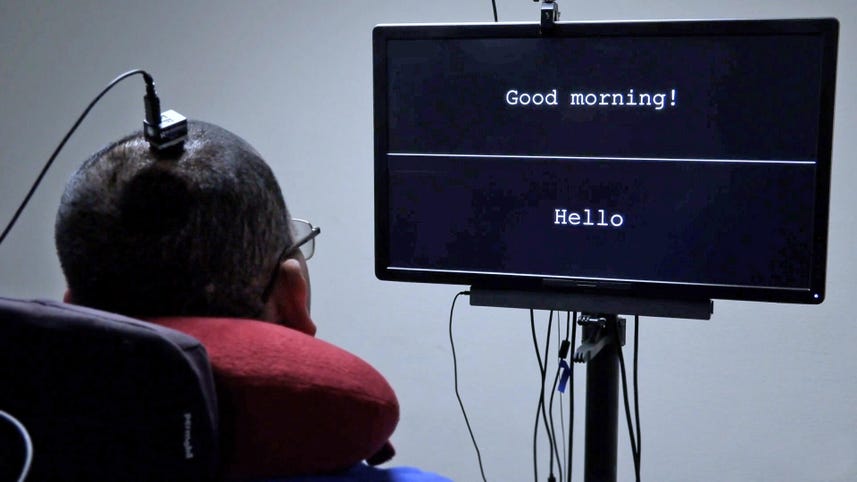
Speaker 1: For the very first time scientists have decoded brain activity, turned it into actual words, all from someone just naturally trying to speak. There are millions of people around the world who don't have disability to speak, but for one of them, things changed recently. Thanks to a landmark study at UC San Francisco.
Speaker 2: It is the most, you know, natural, effortless, expressive, [00:00:30] personal, and efficient way to communicate. And a lot of us take it for granted.
Speaker 1: Dr. David Moses works on the team behind this research. They implanted what they call a neuro prosthesis on the skull. A man who's been paralyzed and unable to speak since he suffered a brain stem stroke 15 years ago,
Speaker 2: It's sort of like a flexible grid of sensors. So in this study, it's 128 sensors, and these are small circular electrodes that [00:01:00] are surgically implanted on the surface of the brain.
Speaker 1: So this grid of sensors picks up neural activation patterns in the cortex, which as it happens is where vocal tract control is processed. Next. They had the man who they refer to as Bravo. One, try to say single words out of a 50 word vocabulary. As he did the at they recorded his brain activity. Then used machine learning to map the brain activity to each word.
Speaker 2: The model can [00:01:30] kind of develop a sense of, okay, when these electrodes are active in this pattern relative to the other electrodes, then I think he's trying to say this word
Speaker 1: After a total of 22 hours of Bravo one's brain activity, it was time to start translating attempted speech into words. The team asked him questions by putting them up on the screen and then asked him to answer using that 50 word vocabulary.
Speaker 2: We, we see that it's happening, you know, right in front of our [00:02:00] eyes, right in front of his eyes. You know, he's very excited about it too. So I mean those, yeah, those are some very special moments for sure.
Speaker 1: Now this system was able to decode up to 18 words per minute at about a 75% accuracy rate. Now, most of us speak at a rate of about 120 to 150 words per minute. So Dr. Moses says the ultimate would be to get the rate closer to that one 20 to one 50. And of course build on that 50 [00:02:30] word vocabulary. Now he wants to make one other thing very clear. This is not mind reading
Speaker 2: This work got posted on Reddit, for example, as soon as it came out and a lot of people were saying that it's gonna be used for interrogations and it's mind reading and your inner thoughts are no longer safe. People are gonna beam advertisements into your brain with this. And I really just wanna emphasize that that for this work it's, it has to be controlled by the person's attempts to speak well. First of all, there's no evidence that decoding [00:03:00] internal thoughts is possible with the current technology.
Speaker 1: Now it's worth noting that Facebook helped fund this study. The company has been working on neural input technology for AR and VR for years, but Facebook appears to be backing away from that. Now going so far as to say, Facebook has no interest in products that require implanted electrodes. The company says going forward, it's focusing on wrist based neural interfaces that said, Dr. Moses says the work at U C S F will [00:03:30] continue beyond Facebook's funding phase
Speaker 2: Bravo one had a brain stem stroke, and that's what caused his disability. But there are people with even more severe disabilities, such as, you know, people with ALS who become locked in basically are only able to move their eyes and sometimes not even that very well. And so if you can really show that this technology can, can decode their attempted speech in a similar fashion as to what we've shown bra one, I think that would, you know, that's, that would [00:04:00] really, really emphasize that this is, this is possible and this can really help people.
Speaker 1: Now this of course is just one of several really exciting recent innovations in brain computer interfaces. Earlier this year, scientists at Stanford used neural implants to give a paralyzed man, the ability to create text on a screen by imagining the act of writing. And then of course there's Elon Musk's Neurolink, which allowed a monkey to play P on a computer using just his brain Musk said the first Neurolink product will [00:04:30] allow a paralyzed person to use a smartphone with their mind faster than someone with their thumbs. So what's the most exciting tech you've seen around brain implants. Let us know in the common, if you enjoy this video, don't forget to give it a thumbs up as always. Thank you so much for watching I'm Andy Altman and I'll see you in the future.